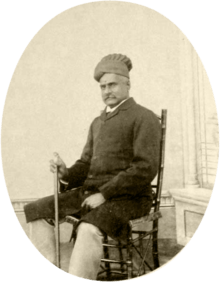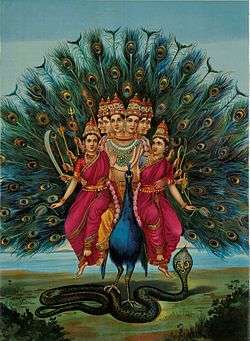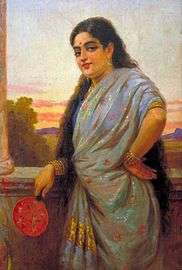Raja Ravi Varma
| Ravi Varma Koil Thampuran | |
|---|---|
 | |
| Born |
April 29, 1848[1][2] Kilimanoor, Travancore |
| Died |
2 October 1906 (aged 58) Attingal, Travancore, British Raj |
| Occupation | Painter, artist |
| Signature | |
 | |
Raja Ravi Varma, Koil Thampuran of Kilimanoor[3][4] (29 April 1848–2 October 1906) was a celebrated Indian painter and artist. He is considered among the greatest painters in the history of Indian art for a number of aesthetic and broader social reasons. Firstly, his works are held to be among the best examples of the fusion of European techniques with a purely Indian sensibility. While continuing the tradition and aesthetics of Indian art, his paintings employed the latest European academic art techniques of the day. Secondly, he was notable for making affordable lithographs of his paintings available to the public, which greatly enhanced his reach and influence as a painter and public figure. Indeed, his lithographs increased the involvement of common people with fine arts and defined artistic tastes among common people for several decades. In particular, his depictions of Hindu deities and episodes from the epics and Puranas have received profound acceptance from the public and are found, often as objects of worship, across the length and breadth of India.
Raja Ravi Varma was closely related to the royal family of Travancore in the deep south of India (Kerala and Tamil Nadu). Later in his life, two of his granddaughters were adopted into that royal family, and their descendants comprise the totality of the present royal family of Travancore, including the latest three Maharajas (Balarama Varma III, Marthanda Varma III and Rama Varma VII).
Personal life
Raja Ravi Varma was born M. R. Ry. Ravi Varma, Koil Thampuran of Kilimanoor at Kilimanoor palace in the erstwhile princely state of Travancore (present-day Kerala)[5] into an aristocratic family that for over 200 years, produced consorts for the princesses of the matrilineal Travancore royal family. The title Raja was conferred as a personal title by the Viceroy and Governor-General of India.[5]
.jpg)
.jpg)
Ravi Varma was the son of Ezhumavil Neelakanthan Bhattatiripad and Umayamba Thampurratti. His mother, Uma Ambabayi Thampuratty (or Umayamba Bayi Thampuratty), belonged to the baronial family which ruled the Kilimanoor feudal estate within the kingdom of Travancore. She was a poet and writer of some talent, whose work Parvati Swayamvaram was published by Varma after her death. Ravi Varma's father, Ezhumavil Neelakanthan Bhattatiripad, was a scholar of Sanskrit and Ayurveda who hailed from the Ernakulam district in Kerala. Ravi Varma had three siblings, a sister named Mangala Bayi, and two brothers named Goda Varma (born 1854) and Raja Varma (born 1860). The last-named was also a painter and worked closely with Ravi Varma all his life.
In 1866, at the age of 18, Varma was married to 12-year-old Bhageerthi Bayi (known formally as Pooruruttati Nal Bhageerathi Bayi Thampuratty) of the royal house of Mavelikkara, another major fief of Travancore kingdom. Notably, the house of Mavellikara was a branch of the Royal House of Travancore. Bhageerthi was the youngest of three sisters, and both of her elder sisters had been adopted into the royal family of Travancore in 1857, in order to carry on the lineage. They were known as the Senior and Junior Rani of Attingal, and in their progeny was vested the succession to the throne of Travancore. Therefore, Ravi Varma's connection to the royal family became very close due to his marriage with Bhageerthi. Indeed, his children (because they belonged to their mother's family) would be royal by birth. The marriage, which was arranged by their parents in the proper Indian manner, was harmonious and successful. The couple were blessed with five children, being two sons and three daughters. Their elder son, Kerala Varma (b.1876) was of an excessively spiritual temperament. He never married and eventually renounced the world, leaving home for good in 1912. The younger son, Rama Varma (born 1879), inherited his father's artistic talent and studied at the JJ School of Arts, Mumbai. He was married to Gowri Kunjamma, sister of Dewan PGN Unnithan, and became the father of seven children.
It was however Ravi Varma's daughters who were singled out by destiny for greatness, although not in the field of art, and not personally but through their daughters. The three daughters of Ravi Varma and Bhageerthi Bayi were Mahaprabha Amma (who features in two of Varma's most famous paintings), Uma Amma (named after Varma's mother) and Cheria Kochamma. In 1900 CE, the Royal House of Travancore once again faced a succession crisis. Bhageerthi's two elder sisters, who had been adopted in order to carry forward the lineage, had failed to produce the desired heirs. They had had six children between them, but only two of those had survived, and both were boys (who also, incidentally, later died childless). According to the matrilineal Marumakkathayam system, the succession to the throne could only progress through females, and therefore it was necessary to make an adoption. Tradition dictated that two girls belonging to branches of the Royal Family be adopted together. They would be designated the Senior and Junior Rani of Attingal, and the succession to the throne of Travancore would be vested in their progeny, in accordance with the unusual and unique Marumakkathayam system of succession.
Two of Varma's grand-daughters were called by destiny to receive this surpassing honour, the main reason being that they were the nearest matrilineal (cognatic) kin to the incumbent Rani of Attingal. In August 1900, Mahaprabha's eldest daughter Lakshmi Bayi (aged 5 years) and Uma's eldest daughter Parvati Bayi (aged 4 years) were adopted into the Royal family of Travancore. It was Bharani Thirunal Lakshmi Bayi, their surviving grand-aunt, who formally adopted them. She died within one year of doing this, and the two girls were then installed as the Senior and Junior Ranis of Attingal respectively. They were married while yet in their early teens to two gentleman from suitable aristocratic families. It was the Junior Rani, Sethu Parvathi Bayi, who gave birth to the much-awaited heir in 1912, exactly the day after her sixteenth birthday. Incidentally, her husband was a grand-nephew of Raja Ravi Varma and belonged to Kilimanoor. The new born child was the future Maharaja Chithira Thirunal, the last ruling Maharaja of Travancore. He was followed by a brother (the future Maharaja Marthanda Varma III) and a sister Lakshmi Bayi, the mother of Maharaja Rama Varma VII who is presently on the throne (since 2013). Meanwhile, the Senior Rani (Sethu Lakshmi Bayi, daughter of Mahaprabha Amma, and Regent in the period 1924-31) also gave birth to two daughters later in life (in 1923 and 1926).
In this way, the entire present (existing) royal family of Travancore are descended from Raja Ravi Varma. Well known among his royal descendants are the writers Aswathi Thirunal Gowri Lakshmi Bayi and Shreekumar Varma, the artist Rukmini Varma and the classical musician Aswathi Thirunal Rama Varma.
Art career
Varma was patronised by Ayilyam Thirunal, the then Maharajah of Travancore and began formal training thereafter.[6] He learned the basics of painting in Madurai. Later, he was trained in water painting by Rama Swami Naidu and in oil painting by Dutch portraitist Theodor Jenson.

The British administrator Edgar Thurston was significant in promoting the careers of Varma and his brother.[7] Varma received widespread acclaim after he won an award for an exhibition of his paintings at Vienna in 1873. Varma's paintings were also sent to the World's Columbian Exposition held in Chicago in 1893 and he was awarded three gold medals.[8] He travelled throughout India in search of subjects. He often modelled Hindu Goddesses on South Indian women, whom he considered beautiful. Ravi Varma is particularly noted for his paintings depicting episodes from the story of Dushyanta and Shakuntala, and Nala and Damayanti, from the Mahabharata. Ravi Varma's representation of mythological characters has become a part of the Indian imagination of the epics. He is often criticized for being too showy and sentimental in his style but his work remains very popular in India. Many of his fabulous paintings are housed at Laxmi Vilas Palace, Vadodara.[9]
Raja Ravi Varma Press

Apparently on the advice of the then Dewan (Prime Minister) of Travancore, T. Madhava Rao, Ravi Varma started a lithographic printing press in Ghatkopar, Mumbai in 1894 and later shifted it to Malavli near Lonavala, Maharashtra in 1899. The oleographs produced by the press were mostly of Hindu gods and goddesses in scenes adapted mainly from the Mahabharata, the Ramayana and the Puranas. These oleographs were very popular and continued to be printed in thousands for many years, even after the 1906 death of Ravi Varma.
The Ravi Varma press was the largest and most innovative press in India at that time. The press was managed by Varma's brother, Raja Varma, but under their management, it was a commercial failure. By 1899 the press was deeply in debt and in 1901, the press was sold to his printing technician from Germany, Fritz Schleicher. Schleicher continued to print Ravi Varma's prints but later employed less talented artists to create new designs. Schleicher also broadened the product of press to include commercial and advertisement labels. Under the management of Schleicher and his successors, the press continued successfully until a devastating fire destroyed the whole factory in 1972. Many of Ravi Varma's original lithographic prints were also lost in the fire.[10]
Honours
In 1904, Viceroy Lord Curzon, on behalf of the British King Emperor, bestowed upon Varma the Kaisar-i-Hind Gold Medal. A college dedicated to fine arts was also constituted in his honour at Mavelikara, Kerala. Raja Ravi Varma High School at Kilimanoor was named after him and there are many cultural organizations throughout India bearing his name. In 2013, the crater Varma on Mercury was named in his honor.[11] Considering his vast contribution to Indian art, the Government of Kerala has instituted an award called "Raja Ravi Varma Puraskaram", which is awarded every year to people who show excellence in the field of art and culture.
List of major works
The following is a list of the prominent works of Ravi Varma.
- Village Belle
- Lady Lost in Thought
- Damayanti Talking to a Swan
- The Orchestra
- Arjuna and Subhadra
- The heartbroken
- Swarbat Player
- Shakuntala
- Lord Krishna as Ambassador
- Jatayu, a bird devotee of Lord Rama is mauled by Ravana
- Victory of Indrajit
- The gypsies
- A Lady Playing Swarbat
- Lady Giving Alms at the Temple
- Lord Rama Conquers Varuna
- Gheevarghese Mar Gregorios of Parumala
- Nair Woman
- Romancing Couple
- Draupadi Dreading to Meet Kichaka
- Shantanu and Matsyagandha
- Shakuntala Composing a Love Letter to King Dushyanta
- Girl in Sage Kanwa's Hermitage (Rishi-Kanya)
- Bharani Thirunal Lakshmi Bayi of Travancore
- Sri Shanmukha Subramania Swami
- Woman holding a fan
- 3D painting of The Mysore king in a horse[available at the Mysore palace]
Gallery



 Damayanti from Mahabharata
Damayanti from Mahabharata Ladies in the moonlight
Ladies in the moonlight
 Simhaka and Sairandhri from Mahabharata
Simhaka and Sairandhri from Mahabharata
 Woman holding a fan
Woman holding a fan Galaxy of Musicians
Galaxy of Musicians The Maharashtrian Lady
The Maharashtrian Lady.jpg) Gypsies
Gypsies Woman Holding a Fruit
Woman Holding a Fruit Portrait of a Lady
Portrait of a Lady Noblemen of Travancore Pillai of Kandamath
Noblemen of Travancore Pillai of Kandamath
In popular culture
- Bollywood film maker Ketan Mehta directed a movie Rang Rasiya on the life of Varma in 2014 in which Randeep Hooda played the role of the artist
- Indian director Lenin Rajendran made a Malayalam movie named Makaramanju (The Mist of Capricorn) in 2010, which narrates Varma's life at a certain stage in his life. Indian director/cinematographer Santhosh Sivan played the lead role of Varma.
- The Marathi textbook of Maharashtra State Board contains a chapter titled 'अपूर्व भेट' meaning 'A Meeting Like Never Before' portraying Varma meeting Swami Vivekananda. It has been edited from the novel 'राजा रविवर्मा (Raja Ravi Varma)' written by Ranjit Desai.
Bibliography
English
- Raja Ravi Varma: Painter of Colonial Indian by Rupika Chawla, Pub: Mapin Publishing, Ahmedabad, March 2010.
- Raja Ravi Varma – Oleographs Catalogueby Dr. D.Jegat Ishwari, Pub: ShriParasuraman, Chennai, 2010, ISBN 9788191002614
- Ravi Varma Classic: 2008, Genesis Art Foundation, Cochin-18;45 clour plate with text by Vijayakumar Menon.
- The Painter: A life of Ravi Varma by Deepanjana Pal Random House India, 2011 ISBN 9788184002614
- Raja Ravi Varma – The Most Celebrated Painter of India: 1848–1906, Parsram Mangharam, Bangalore, 2007
- Raja Ravi Varma – The Painter Prince: 1848–1906, Parsram Mangharam, Bangalore, 2003
- Raja Ravi Varma and the Printed Gods of India, Erwin Neumayer & Christine Schelberger, New Delhi, Oxford University Press, 2003
- Raja Ravi Varma: The Most Celebrated Painter of India : 1848 – 1906, Classic Collection, Vol I & II. Bangalore, Parsram Mangharam, 2005
- Raja Ravi Varma: Portrait of an Artist, The Diary of C. Raja Raja Varma/edited by Erwin Neumayer and Christine Schelberger. New Delhi, Oxford University Press, 2005
- Divine Lithography, Enrico Castelli and Giovanni Aprile, New Delhi, Il Tamburo Parlante Documentation Centre and Ethnographic Museum, 2005
- Photos of the Gods: The Printed Image and Political Struggle in India by Christopher Pinney. London, Reaktion Book, 2004
- Raja Ravi Varma:Raja Ravi Varma:E.M Joseph Venniyur,former director of AIR
- Raja Ravi Varma: A Novel, Ranjit Desai -Translated by Vikrant Pande, Pub: Harper Perennial (2013), ISBN 9789350296615
Malayalam
- Ravi Varma – A critical study by Vijayakumar Menon, Pub: Kerala Lalitha Kala Akademy, Trissur, 2002
- Raja Ravi Varmayum chitrkalayum, Kilimanoor Chandran, Department of Cultural Publications, Kerala Government, 1999.
- Chithramezhuthu Koyithampuran, P. N. Narayana Pillai.
- Raja Ravi Varma, N. Balakrishnan Nair.
Marathi
- "Raja Ravi Varma", a novel by Marathi language novelist Ranjit Desai translated into English by Vikrant Pande.
See also
Notes and references
- ↑ Joshi, Om Prakash (1985). Sociology of Indian art. Rawat Publications. p. 40.
- ↑ K.R.N. Swamy (28 April 2002). "A great painter, no doubt, but controversial too". Spectrum–The Tribune. Retrieved 28 October 2014.
- ↑ Nagam Aiya, The Travancore State Manual
- ↑ "Restoring works of art". The Hindu. Retrieved 18 April 2015.
- 1 2 PAL, DEEPANJANA (2011). THE PAINTER. Random House India. ISBN 9788184002614. Retrieved 18 April 2015.
- ↑ "The Diary of C. Rajaraja Varma"
- ↑ Mitter, Partha (1994). Art and Nationalism in Colonial India, 1850-1922: Occidental Orientations. Cambridge University Press. pp. 69, 193, 208. ISBN 978-0-52144-354-8.
- ↑ Kilimanoor Chandran, Ravi Varmayum Chitrakalayum(in Malayalam), Department of Culture, Kerala, 1998.
- ↑ Vadodara, Lakshmi Vilas Palace. "Raja Ravi Varma Paintings, Vadodara". www.historyofvadodara.in.
- ↑ Davis, Richard (2012). Gods in Print: Masterpiece of India's Mythological Art. San Rafael, California: Mandala Publishing. p. 83. ISBN 9781608871094.
- ↑ "Gazetteer of Planetary Nomenclature".
External links
| Wikimedia Commons has media related to: |
- http://www.rajaofart.com/useful-links/ More than 100 Links to all the news and articles on Raja Ravi Varma Oleographs and exhibitions from 2005 to 2015.
- http://ravivarma.org Raja Ravi Varma Art Gallery
- http://www.ravivarmaoleographs.com/ single largest collection
- http://www.cyberkerala.com/rajaravivarma/ Ravi Varma's Paintings
- http://ravi.varma.lithos.googlepages.com/ Largest collection of the Lithographs from the Ravi Varma Press
- The Hindu: The royal artist by K.K. Gopalakrishnan
- http://www.barodaart.com/ 1000 Oleographs from Raja Ravi Varma Press shown as Slide show
- http://www.rajaofart.com/ All about Raja Ravi Varma of Kilimanoor's life, paintings, Oleographs,Digital Library 3.1 at Kilimanoor Palace and Digital Library 3.2 at M S University, Faculty of Fine Arts, Baroda,movies,News & comments}
- The Tribune article about him